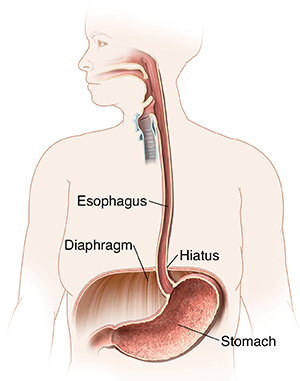What Is a Hiatal Hernia?
What Is a Hiatal Hernia?
Hiatal hernia is when the area where the stomach and esophagus meet bulges up through the diaphragm into the chest cavity. In some cases, part of the stomach may bulge above the diaphragm. Stomach acid may move up into the esophagus and cause symptoms. The symptoms are often blamed on gastroesophageal reflux disease (GERD). You may only know about the hernia when it shows up on an X-ray taken for other reasons.
What you may feel
The hiatus is a normal hole in the diaphragm. The esophagus passes through this hole and leads to the stomach. In some cases, part of the stomach may bulge above the diaphragm. This bulge is called a hernia. Stomach acid may move up into the esophagus and cause symptoms.
When you eat, the muscle at the hiatus relaxes to allow food to pass into the stomach. It tightens again to keep food and digestive acids in the stomach.
Many people with hiatal hernias have mild symptoms. You may notice the following GERD symptoms:
Heartburn or other chest discomfort
A feeling of chest fullness after a meal
Frequent burping
Acid taste in the mouth
Trouble swallowing
Treating symptoms
If you have been diagnosed with hiatal hernia, these suggestions may help improve symptoms:
Lose excess weight. Extra weight puts pressure on the stomach and esophagus.
Don’t lie down after eating. Sit up for at least an hour after eating. Lying down after eating can increase symptoms.
Avoid certain foods and drinks. These include fatty foods, chocolate, coffee, mint, and other foods that cause symptoms for you.
Don’t smoke or drink alcohol. These can worsen symptoms.
Look at your medicines. Discuss your medicines with your healthcare provider. Many medicines can cause symptoms.
Consider an antacid medicine. Ask your healthcare provider about over-the-counter and prescription medicines that may help.
Ask about surgery, if needed. Surgery is a treatment choice for some people. Your healthcare provider can determine if surgery is an option for you.
Updated:
May 08, 2017
Reviewed By:
newMentor board-certified, academically affiliated clinician,Sather, Rita, RN

